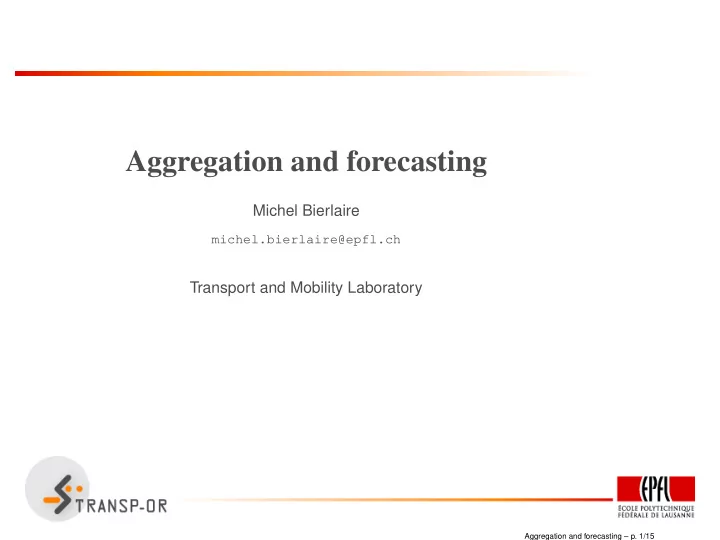

Aggregation and forecasting Michel Bierlaire michel.bierlaire@epfl.ch Transport and Mobility Laboratory Aggregation and forecasting – p. 1/15
Aggregation • So far, prediction of individual behavior • In practice, not useful • Need for forecast of aggregate demand: • number of trips • number of passengers • etc. Aggregation and forecasting – p. 2/15
Aggregation Linear models t n = α + βp n where • t n : number of trips from zone n • p n : population in zone n • If ¯ p is the average population • ¯ t = α + β ¯ p is the average number of trips It does not work with choice models, because they are nonlinear Aggregation and forecasting – p. 3/15
Aggregation • “Travel/no travel” model, y n income No travel V 1 = 0 Travel V 2 = − 3 + 3 y n Income V1 V2 P1 P2 Household 1 1 0 0 50% 50% Household 2 10 0 27 0% 100% Avg. income 5.5 0 13.5 0% 100% Avg. probabilities 25% 75% Aggregation and forecasting – p. 4/15
Aggregation • Choice model P ( i | x n ) where x n gathers attributes of all alternatives and socio-economic characteristics of n • If the population is composed of N individuals, the total expected number of individuals choosing i is � N N ( i ) = P ( i | x n ) n =1 • Hopeless to know x n for every and each individual • The sum would involve a lot of terms. • The distribution of x could be used. Aggregation and forecasting – p. 5/15
Aggregation • Assume that the distribution of x is continuous with PDF p ( x ) • Then the share of the population choosing i is given by � � W ( i ) = P ( i | x ) p ( x ) dx x • In practice, p ( x ) is also unknown • The integral may be cumbersome to compute Aggregation and forecasting – p. 6/15
Aggregation • If the population is segmented in S homogeneous segments • If N s is the number of individuals in segment s • Then � S � N ( i ) = N s P ( i | x s ) s =1 Aggregation and forecasting – p. 7/15
Illustration The travel model: • “Travel/no travel” model, y n income e − 3+3 y n P ( travel ) = 1 + e − 3+3 y n • Population: N = 200’000 persons • Sample: S = 500 persons • Sampling rate: S/N = 1/400 Aggregation and forecasting – p. 8/15
Illustration P (travel) s y s S s N s PS s PN s 1 0 150 20000 4.7% 7 949 2 0.5 200 30000 18.2% 36 5473 3 1 40 50000 50.0% 20 25000 4 1.5 10 50000 81.8% 8 40879 5 2 50 30000 95.3% 48 28577 6 2.5 50 20000 98.9% 49 19780 500 200000 169 120657 120657 � = 400 × 169 = 67542 People with low probability of travel are oversampled Aggregation and forecasting – p. 9/15
Aggregation Most practical method: sample enumeration • Let n be an observation in the sample belonging to segment s • Let W s be the weight of segment s , that is = # persons in segment s in population W s = N s # persons in segment s in sample S s • The number of persons choosing alt. i is estimated by � � � N ( i ) = W s P ( i | x n ) I ns s n ∈ sample where I ns = 1 if individual n belongs to segment s , 0 otherwise Aggregation and forecasting – p. 10/15
Aggregation We can write � � � N ( i ) = W s P ( i | x n ) I ns n ∈ sample s � � = P ( i | x n ) W s I ns n ∈ sample s The term � s W s I ns is the weight of individuals n belonging to segment s . The share of alt. i is estimated by W ( i ) = � � � � 1 N s 1 P ( i | x n ) W s I ns = P ( i | x n ) I ns N N S s s s n ∈ sample n ∈ sample Aggregation and forecasting – p. 11/15
Forecasting • Modify x n in the sample to reflect anticipated modifications • Apply the sample enumeration again Aggregation and forecasting – p. 12/15
Example s y s S s P(travel) W s Trips 1 0 150 4.74% 133.33 949 2 0.5 200 18.24% 150 5473 3 1 40 50.00% 1250 25000 4 1.5 10 81.76% 5000 40879 5 2 50 95.26% 600 28577 6 2.5 50 98.90% 400 19780 120657 • Increase all salaries by 0.5 • What is the impact on the total number of trips? Aggregation and forecasting – p. 13/15
Example s y s S s P(travel) W s Trips 1 0.5 150 18.24% 133.33 3649 2 1 200 50.00% 150 15000 3 1.5 40 81.76% 1250 40879 4 2 10 95.26% 5000 47629 5 2.5 50 98.90% 600 29670 6 3 50 99.75% 400 19951 156777 • Before: 120657 • After: 156777 • Increase: about 30% Aggregation and forecasting – p. 14/15
Summary • Aggregation: • Sample enumeration. • Correct for sampling errors using weights. • Forecasting: • Forecast the value of the explanatory variables x . • Aggregate. Aggregation and forecasting – p. 15/15
Recommend
More recommend